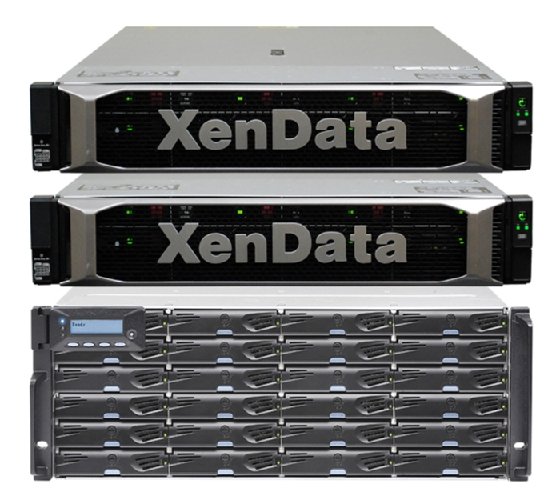
Getty Images
XenData's X100 provides 100-plus PB active archive
XenData's X100 brings an active archive to market that's designed to target the explosive growth in unstructured data, such as customers in media and entertainment.
As company data grows, so does its needs for archive technology that can grow along with it. XenData's new active archive can scale to over 100 petabytes of storage with fast restore speeds.
The XenData X100, which is now generally available, comes with three common interfaces -- file folder, object and XMI API -- that can be used simultaneously. The active archive can manage several libraries of either linear tape-open (LTO) from HPE, IBM, Oracle, Qualstar, Quantum, Sony and Spectra Logic or Optical Disc Archive (ODA) libraries from Sony with no single point of failure.
The XenData X100 is either a storage server or a cluster with associated switches that manage robotic tape libraries and can be used with a cloud gateway for additional copies of the data and colder archive, according to Phil Storey, CEO at XenData.
The X100 supports all the major removable media vendors, according to Vinny Choinski, an analyst at Enterprise Strategy Group (ESG), a division of TechTarget. It also aligns with renewed enterprise interest in using active archives more effectively, particularly with the uptick in unstructured data or data that cannot be easily stored in a traditional database, he said.
"Unstructured data is growing at [an annually estimated average of] over 34% -- not 10% or 20%, but 34%," he said. "That is a large amount of growth."
With unstructured data showing this much growth, active archives become good candidates for storage, he said.

Near limitless capacity
The XenData X100 can scale to 100-plus petabytes, scaling up to the physical limits of the tape libraries that are connected to it, which, in theory, could grow into exabytes, Storey said. Still, he's careful not to call it unlimited storage.
"Saying something has unlimited capacity doesn't mean anything," he said, adding that the X100 "will go as big as you ever needed it to."
The X100 was a progression of capacity, Storey said. XenData released the X20 and X40 at the end of 2020 as entry-level products that can manage two or four LTO tapes, respectively. The X100 is on the other end of the spectrum, targeted at industries with rich media that needs to be archived but accessible for extended periods of time.
But with 34% growth in unstructured data per year on average and longer retention requirements, the need for higher storage capacity such as what X100 offers is going up, according to Choinski.
In a 2021 survey of 150 IT professionals in charge of data protection, ESG found that the average retention time for archive data was 10 years, with some retention times being as high as 15 years. The average capacity for an active archive, which preserves critical data while ensuring it can still be accessed, was 4 petabytes.
However, the ultra-high capacity brings its own set of limitations, Storey said. The X100 is currently a niche product mainly directed at media and entertainment customers that want to keep their content.
Not just capacity, but performance as well
Some customers treat their active archives like a big RAID array, Storey said. They need to store large amounts of data while also being able to do many restores a day.
Speaking theoretically, Storey said to take, for example, 10 LTO-9, enterprise-class Fibre Channel drives 400 MBs. Aggregating the performance of the drives comes to 4 GB/s.
"That's well within the capabilities of the system," he said.
XenData enables partial file restoration, something that is more prevalent in media and entertainment where only portions of large files are needed to create a clip or trailer.
The X100 relies on proprietary software, XenData Archive Series Version 7, to provide the high restore performance. The software allows multi-threading between the dual processes of the server, taking advantage of both, Storey said. The software enables XenData to match the Fibre Channel ports to the processer, which can add other benefits such as multipath I/O (MPIO).
Capacity, performance and beyond
The X100 is built on Windows Server 2022, the preferred operating system for media and entertainment companies, according to Storey. MPIO is built into the Microsoft framework, which adds redundancy in case of a hardware failure.
"If a switch goes down, there's another switch that will take over," Storey said.
ESG's Choinski said that active archives need to be available to be useful. Entertainment and media customers, but also those in scientific research or the oil and gas industry, need to extract data over time, making high availability a critical asset.
Other X100 features include XenData's Multi-Site Sync, which can synchronize tape libraries, and its object storage support.
Another feature of the X100 is the ability to add a cloud gateway, which acts as a bridge between the active archive and the public cloud, using object storage. XenData supports AWS, Azure and Wasabi. With AWS and Azure, customers can choose instant access through S3 and Azure Cool or Hot tiers; they can also create another copy for long-term storage.
"You can use the lifecycle management that's available from those two suppliers, and then just tier it to a more cost-effective archive like deep Glacier or Microsoft archive," Storey said.
An X100 system starts at $74,000 for a single server system, with a 112 TB RAID to manage a 2.7 PB LTO library.







